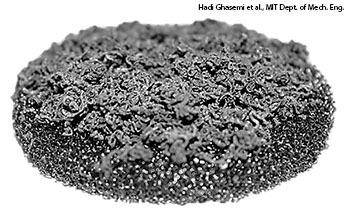
Double-layer structure consists of a carbon foam supporting an exfoliated graphite layer. Both layers are hydrophilic to promote the capillary rise of water to the surface.
Solar-powered steam technology is not new, but it generally requires moderate to high optical concentration of sunlight with the potential for significant losses. Researchers at the Massachusetts Institute of Technology (U.S.A.) have developed a simple, highly efficient carbon-based technique for capturing sunlight and generating steam (Nature Commun., doi:10.1038/ncomms5449).
The device (with no moving parts) consists of a double-layered, porous structure of graphite flakes and carbon foam floating on the top of a container of water. Both layers are hydrophilic; the carbon foam acts an insulator and also supports the exfoliated graphite, which absorbs 97 percent of the solar irradiation (wavelengths of 250 to 2,250 nm) that falls on it.
When sunlight hits the carbon double-decker, the top layer absorbs the energy and heats up. The capillary action of both layers draws the water upward, where the fluid also heats up and turns into steam. After an initial period of warming up, the system reaches a constant water-evaporation rate that is measurably higher than a container of water standing alone. And, unlike steam generation via boiling water, the water left behind in the vessel remains at the ambient temperature.
According to the researchers, led by postdoctoral fellow Hadi Ghasemi and mechanical engineering department head Gang Chen, the double-layer carbon structure achieves up to 85 percent efficiency under illumination of 10 kW per square meter. (Thermal efficiency at 1 kW per square meter of irradiation, which is closer to the actual level of incoming sunlight received on Earth, is 64 percent.)
Steam arising from the carbon foam could go into a small-scale collection system for clean water in remote areas where sunlight is the only reliable source of power. The MIT team seeks to improve the solar steam technique by decreasing the flow rate through the carbon foam, or perhaps replacing the foam with a material with greater insulating properties.
